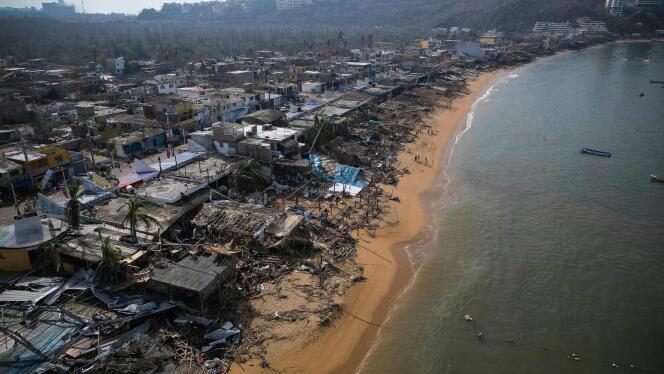
Defects in urbanization in the Mexican city of Acapulco, most notably the devastating Hurricane Otis

In the Mexican city of Acapulco, a week after Hurricane Otis, a Category 5 on the Saffir-Simpson scale, during the night of October 24 to 25, the extent of the damage became clearer, while human losses rose. 46 dead and 58 missing. Pictures of looted hotels, which circulated shortly after the disaster, did not actually show the most serious urban devastation. These buildings on the fringes of the Pacific Ocean’s shores, which received the heaviest gusts of wind, saw their interior architecture destroyed, but their concrete structure still stands. On the other hand, in remote neighborhoods, where houses are built of sheet metal, wood or brick, there is often nothing habitable.
This is confirmed by the satellite map of the European Union Space Program (Copernicus), published on Sunday, October 29, which represents the most devastated areas in red. If we superimpose it with a map of Acapulco from government social services, the poorest neighborhoods are the areas most devastated by Hurricane Otis..
In the case of Acapulco, poor urban planning in coastal areas also did not help prevent the disaster. According to this specialist, the tourism sector has all the facilities necessary to build on the beachfront, with few restrictions. “If we compare with Rio de Janeiro [au Brésil] For example, there is an average distance between the sea and the first building of 210 meters to accommodate the potential rise in sea leveldefines urban planner Federico Taboada. In Acapulco there are only 13 metres. »
According to a preliminary assessment, 580,000 people lost their homes, 7,000 hectares of buildings were destroyed or damaged, and more than 900 kilometers of roads and streets were flooded or damaged. The Mexican Insurance Association estimated the damage at about $15 billion (14.2 billion euros), ranking Hurricane Otis among the ten most expensive disasters in the country’s history. But insurance companies won’t do much about it in the end: only 7% of properties (16,000 buildings and 20,000 cars) are insured. Therefore, the state will bear the majority of the costs associated with the disaster.
“Giving priority to the most deprived areas”
The challenge facing Mexican authorities is enormous: getting a city of nearly a million people back on its feet and trying to right its urban planning mistakes. “For once, we must prioritize the most deprived areas.”, Federico Taboada pleads again. At the moment, President Andrés Manuel López Obrador, known as AMLO (centre-left), has not mentioned such a project, even if he allowed tax cuts on Monday, October 30 to facilitate the reconstruction.
You have 40% of this article to read. The rest is reserved for subscribers.

“Unapologetic pop culture trailblazer. Freelance troublemaker. Food guru. Alcohol fanatic. Gamer. Explorer. Thinker.”
